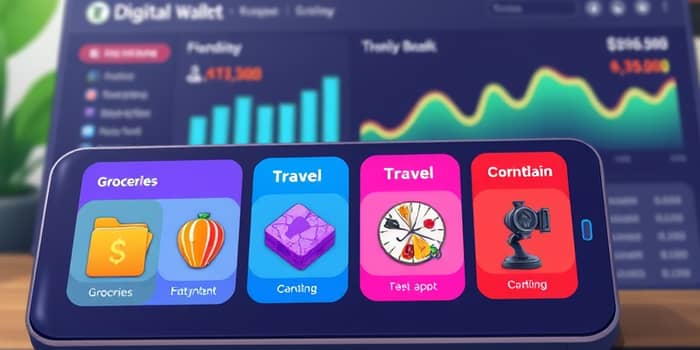In a world where digital payments dominate, having the right tools to manage your card usage is no longer optional—it’s essential. From everyday groceries to spur-of-the-moment online splurges, every swipe, tap, or click adds up. To maintain control over your finances and avoid unexpected debt, turning on specialized spend controls can make all the difference.
Whether you carry multiple credit lines or rely on a single debit card, understanding how to selectively freeze spending by category is a game-changer. By applying targeted restrictions, you can safeguard your budget, prevent fraud, and build healthy financial habits without sacrificing convenience.
A Dynamic Credit Card Landscape
The sheer volume of card-based payments in the United States has grown at a record pace. Consumers now hold nearly four credit cards apiece, and contactless and virtual cards multiply rapidly in digital wallets.
As of 2025, there are over 800 million credit cards in circulation, reflecting a robust appetite for convenient, rewards-driven spending. Credit and debit cards together account for roughly one-third of all U.S. payment transactions, while digital wallets claim half of the global payment share.
Despite a preference for debit products among certain groups, credit usage continues its steady rise. Global purchase volume for U.S. cards reached $5.82 trillion and is projected to climb to $6.33 trillion by 2026, reinforcing the need for tools that help users manage their outflows effectively.
Below is a snapshot of key metrics illustrating this landscape:
Digital wallets now command roughly half of global payment volume, driven by mobile-first habits and growing contactless adoption. As these figures rise, so does the importance of precise spend-management features.
With high interest rates and borrowing costs straining household budgets and overall consumer confidence, tools that enable proactive restriction of discretionary outflows have become invaluable.
Understanding Card Freezing and Category Controls
At its core, a card freeze is a temporary suspension that stops all new authorizations without permanently closing the account. It’s ideal for lost cards, suspected fraud, or short-term blackout periods when you need a financial pause.
Category controls take this concept further by letting you define merchant segments—such as gas stations, online retail, travel, or dining—where transactions are automatically declined. These blocks rely on standardized merchant category codes, ensuring consistent enforcement no matter where you shop.
Many apps also allow geo-fencing: freezing a card when it’s used outside specific geographic zones or time windows. Combined with custom spending thresholds, this functionality delivers a powerful, context-aware shield against unwanted charges.
When integrated into a streamlined interface, category controls can trigger alerts as thresholds near, giving you a chance to adjust or override settings before you hit a hard stop.
Who Benefits from Spend Controls?
Spending controls serve a diverse array of needs across both personal and professional contexts. By shaping how and where cards can be used, these features empower users to stay on track and avoid financial slip-ups.
From young adults learning discipline to parents overseeing allowances, the ability to impose guardrails on card usage brings clarity and peace of mind.
- Individuals seeking controlled budgets and mindful spending.
- Parents monitoring allowances for teenage or college-age children.
- Business owners limiting employee expenses to approved categories.
- Joint account holders coordinating shared household spending.
- Consumers aiming to pay down debt more quickly.
By setting limits on non-essential purchases, users can enforce accountability and encourage reducing impulsive spending habits that often derail long-term goals.
Tools and Features Offered by Banks and Fintechs
Responding to rising demand, many financial institutions now embed advanced spend-management tools directly into their mobile applications. Customers can toggle features on or off, switch between physical and virtual cards, and review detailed spending reports in real time.
Leading platforms provide split-second insights with real-time analytics for spending patterns, making it easy to spot category overages at a glance.
- Real-time transaction alerts for each purchase.
- category-based monthly budget caps to limit spend in select segments.
- Ability to temporarily pause or freeze a card with one tap.
- Comprehensive spending analytics and merchant insights.
By consolidating these functions into a single interface, there’s no longer a need for external spreadsheets or manual trackers—everything you need to control spending is just a tap away.
Economic Drivers Fueling Demand for Controls
We live in an environment where borrowing costs remain elevated and everyday price inflation continues to bite into household budgets. Consumers carrying revolving balances are particularly vulnerable to rising APRs.
At the same time, discretionary spending on travel, entertainment, and big-ticket purchases has slowed, prompting banks and fintechs to offer innovative safeguards that align with cautious spending behaviors.
- Elevated borrowing costs and increased APRs.
- Slowdown in discretionary spending momentum.
- Persistent inflation on everyday goods.
- Rapid growth of digital payment options.
Together, these forces drive the adoption of AI-driven alerts and automatic freezes that can intervene when spending patterns deviate from established budgets or when unusual activity is detected.
Real-Life Scenarios: Preventing Overspending in Action
Scenario 1: Sarah, a mid-level marketing manager, noticed her monthly dining charges creeping upward as she socialized more frequently. By freezing entertainment and restaurant categories over the weekend, she curbed weekend splurges and redirected savings to an emergency fund.
Scenario 2: Jorge runs a small design firm and issues cards to contractors. He implemented category blocks so that team members could only use cards at approved travel and lodging providers, eliminating unauthorized purchases and improving expense reporting accuracy.
Scenario 3: A young couple shared a joint credit card but found themselves arguing over who spent on what. With individualized category limits, they each set personal caps on online shopping and subscriptions, which eased tension and fostered open dialogue about priorities.
These examples illustrate how granular controls can adapt to varied lifestyles and needs, transforming abstract limits into financial freedom and peace of mind.
Future Outlook: AI and the Next Generation of Spend Management
Looking ahead, the convergence of artificial intelligence and financial services promises even smarter solutions. AI models may soon predict upcoming recurring charges and propose customized spending plans, sending gentle nudges weeks before large bills are due.
Next-gen platforms will likely analyze transactions in near real time and trigger proactive interventions—such as automated freezes on high-risk or out-of-pattern charges—before balances can spike uncontrollably.
Furthermore, deeper integration with digital wallets and biometric authentication could allow users to approve or deny exceptions seamlessly, blending security with convenience.
As these technologies mature, the line between budgeting, fraud prevention, and personalized coaching will blur, empowering every cardholder to stay ahead of debt traps.
Conclusion
Modern payment tools offer unprecedented control over when, where, and how cards can be used. By weaving category-based safeguards into daily financial habits, users can proactively avoid pitfalls such as “bill shock” and runaway interest charges.
Whether for personal budgeting, parental oversight, or business expense management, the ability to apply precise spending rules represents a significant leap toward responsible money management. Embrace these features today to take command of your financial future and navigate tomorrow’s challenges with confidence.
Embracing these controls now prepares you for an unpredictable economic landscape, where agility and precision in spending will define who thrives.
References
- https://use.expensify.com/blog/credit-card-statistics
- https://www.lendingtree.com/credit-cards/study/credit-card-debt-statistics/
- https://ramp.com/blog/credit-card-statistics
- https://www.sellerscommerce.com/blog/credit-card-statistics/
- https://eyeonhousing.org/2025/05/consumer-credit-slows-in-the-first-quarter-of-2025/
- https://found.com/legal/piermont-account-terms
- https://www.cardrates.com/news/credit-card-usage-statistics/










